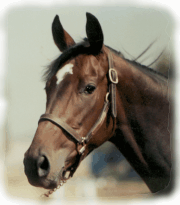|
|
|
A
Horse of Course
with Don Blazer
|
 |
You don't pull the
mask off the old Lone Ranger, and you
don't say Silver was a weakling or had poor eyesight.
And you don't call El Cid "babieca" (idiot), or express
doubts about the choice of horses ridden by Emperor Hirohito of Japan,
or
Napoleon or Gen. Zachary Taylor.
They all rode Albinos, as did many kings, queens, knights,
commanding generals and Indian chiefs.
If you made disparaging remarks about their horses you might
find they didn't take it kindly, and some of them could be pretty rough
characters.
But to make matters worse, you'd be perpetuating the
misconceptions that the albino horse is weak, has poor eyes, dies young
and
is white. You see, most albinos aren't.
The true albino, which may occur in any form of animal or
plant life, is a freak of nature with no color pigment. And since nature
takes care of her own faults, the true albino animal is weak and often
does
die at an early age.
But in the vast majority of cases, the white horse is just
that--white--not albino.
There actually was an active American Albino association with
registered white horses as a color type rather than a no-color breed.
The foundation sire of the American Albino Association of
Crabtree, Ore., was Old King, a horse said to be 15.2 hands, strongly
built,
with the necessary pink skin color, snow-white hair and silky mane and
tail.
He was believed to be of Arabian-Morgan stock and exhibited great endurance
and vigorous character. Foaled in 1906, Old Kind had the reputation of
throwing all white foals from solid-colored mares.
While coloring was the primary requisite for registration in
the Albino association, ancestry was of any breed.
The association had three color categories, American White,
American Albino and American Creme. All had snow, or milk-white hairs
with
underlying pinkish skin, brown, blue, black or hazel eyes. None had "pink
eyes" as the name Albino would suggest.
It is said the horses registered are exceptionally docile,
smart and tractable. Albinos are popular as pleasure riding horses, as
well
as for draft work and entertainment spectaculars such as six abreast jumping
exhibitions. You have, of course, seen many white horses as circus
performers.
Throughout history the white horse has always been associated
with the purity of the hero. While horse, white hat. Middle Age and
Renaissance painters often pictured their subjects on white horses,
especially when the subjects were kings and queens.
Knights like white horses too, and maybe for the same reason
that many cavalry commanders picked them. They are easily seen during
the
heat of battle, which is good for morale and as a rallying point.
El Cid chose a white horse which was scrawny, ugly and
bedraggled. his choice of a horse caused people to refer to El Cid as
'babieca', which mean idiot. But the horse wasn't, nor, as it turn out,
was
El Cid. Through proper care, El Cid turned the colt into a magnificent
war
horse which carried his master to many victories.
Other famous generals who rode white horses were Napoleon,
who owned more than 50 of them, and Gen. Zachary Taylor, who owned only
one--Old Whitey.
Mont Blanc, winner of the l966 Woodmansterne Handicap in
Epsom Down, England, was only one of several good white Thoroughbred race
horses.
And finally, there are the famous white horses of American
folklore, those ridden by the cowboy heroes who entertained us on the
silver
screen.
Hoppalong Cassidy rode a white horse. But do you remember
his name?
I don't.
But I'll never forget the name of the Lone Ranger's horse.
"Hi ho, Silver (Silver Pride) ......away." And the masked
man rode off on the fiery horse with the speed of light.
|

